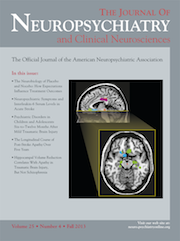Comparison of the Profile of Patients With Acute and Transient Psychotic Disorder and Schizophrenia in a Nigerian Teaching Hospital
Abstract
Acute and transient psychotic disorders (ATPD) are different from schizophrenia; however, very little research has been done on this disorder in low-income countries, where the incidence is as high as 10 times the incidence in the more developed countries. The authors sought to identify/characterize the sociodemographic and clinical differences between the two disorders by performing a retrospective review of the records of patients with untreated first episode of ATPD and schizophrenia seen at the University College Hospital, Ibadan, between January 1, 2006 and December 31, 2010, extracting sociodemographic and clinical data. A group of 243 patients with schizophrenia and 124 subjects with ATPD met the inclusion criteria. Patients with ATPD were more likely to present below the age of 25 years. Excitement was more common in ATPD than in schizophrenia; suspiciousness was more common in subjects with schizophrenia than ATPD. Also, anxiety and uncooperativeness were significantly more likely to occur in ATPD. Poor orientation, disturbance of volition, and preoccupation were more common in schizophrenia. The mean age at onset was similar between patients with schizophrenia and ATPD. In keeping with findings in Europe and North America, there are clinical and sociodemographic differences between ATPD and schizophrenia; however, a different set of features differentiate between the two conditions in Nigerians.



